What are hurdles to 3D printing technology advancing further?
-
Mar, 30 2023
-
0 Comments

Analyzing the Barriers to Further Advancements in 3D Printing Technology
3D printing has become an increasingly popular technology that has revolutionized the way we create products or objects. It has become increasingly accessible to the general public and has made the production of goods simpler, faster and cheaper. However, while 3D printing has made great progress, there are still some critical hurdles that need to be overcome in order for this technology to reach its full potential.
One of the primary issues with 3D printing technology is the lack of quality materials. The materials that are currently available for 3D printing are limited in terms of strength, durability, and cost. This limits the quality of products that can be created using 3D printing, and hinders the technology’s potential. Furthermore, 3D printing is limited by the size of the object that can be printed. Most 3D printers are limited to objects that are only a few inches in size. This prevents the technology from being used for larger projects, such as the construction of buildings.
The cost of 3D printing is also a major barrier. 3D printers are expensive, and the materials used are costly as well. This makes it difficult for individuals and organizations to access the technology. Furthermore, 3D printing is still a relatively slow process, when compared to traditional manufacturing methods. This limits the speed at which products can be produced, and makes the technology less attractive to businesses.
Finally, 3D printing technology is still in its early stages. This means that there is a lack of knowledge and understanding of the technology, which hinders its advancement. Additionally, the software that is used to create 3D printed objects is complex and difficult to use. This makes it difficult for people to learn the technology and limits its potential.
In conclusion, 3D printing has made great strides in recent years, but there are still some significant barriers that must be overcome in order for the technology to reach its full potential. The lack of quality materials, the cost of the technology, the slow speed of production, and the lack of knowledge and understanding of the technology all stand in the way of further advancements in 3D printing.
Overcoming the Challenges to Unlock the Potential of 3D Printing Technology
3D printing technology has the potential to revolutionize the way we produce and consume products. It offers a more efficient and cost-effective way to create a variety of objects. But there are several hurdles that must be overcome in order for 3D printing technology to reach its full potential.
Cost
One of the biggest hurdles to advancing 3D printing technology is the cost. 3D printers can be expensive, and the materials used can be even more costly. This makes it difficult for businesses to invest in the technology, and it can limit its widespread adoption.
Time
Another challenge is the time it takes to print an object. Depending on the complexity of the object, the printing process can take several hours or even days. This means that the technology is still not suitable for mass production, which limits its use in certain industries.
Materials
The materials used in 3D printing are also limited. Many 3D printers are not able to print with a wide range of materials, which can limit the functionality of the objects produced. The materials used also need to be strong and durable, which is not always possible with 3D printing.
Software
The software used in 3D printing is also a hurdle. It can be difficult to create the models needed for the objects, and the software used to do so can be expensive and complicated. This can be a barrier to entry for those who are unfamiliar with the technology.
Expertise
Finally, 3D printing requires a certain level of expertise. Not everyone has the skills needed to design, build, and maintain a 3D printer. This can make it difficult for businesses to find the right personnel to work with the technology.
These are just a few of the challenges that need to be addressed in order for 3D printing technology to reach its full potential. With the right investments, the technology could revolutionize the way we produce and consume products.